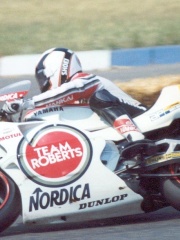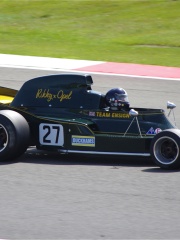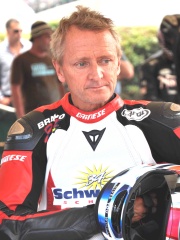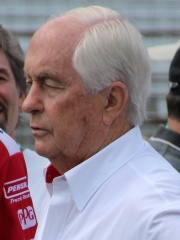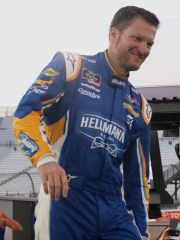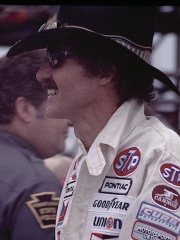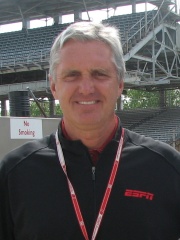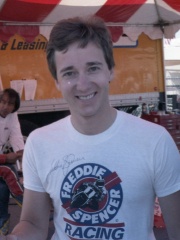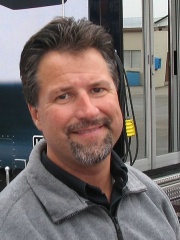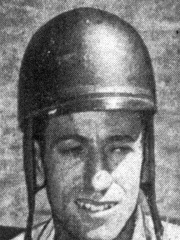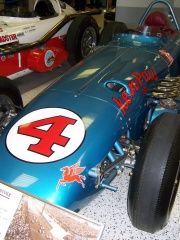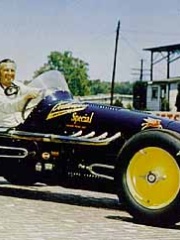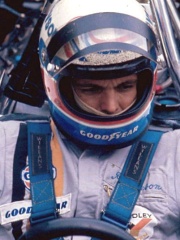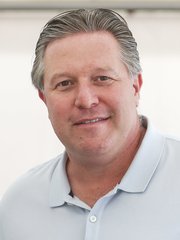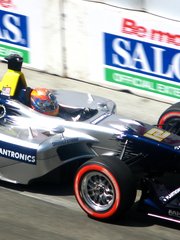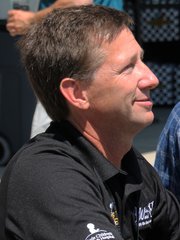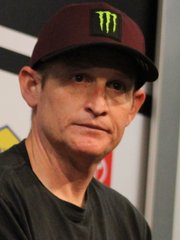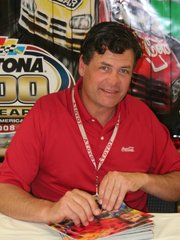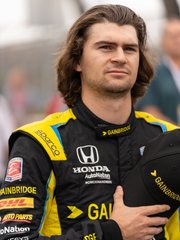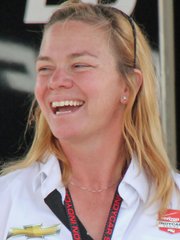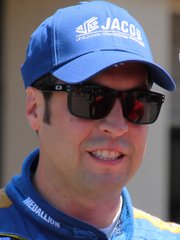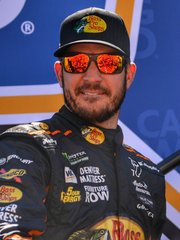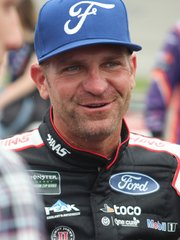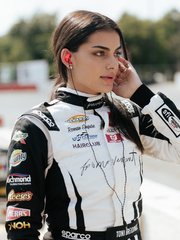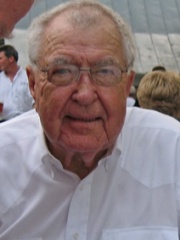
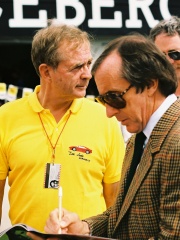
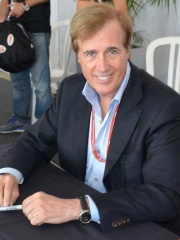
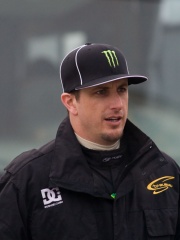
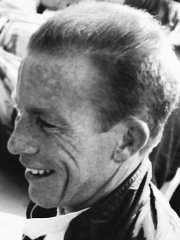

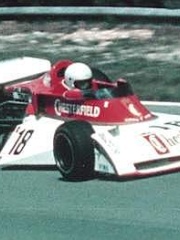
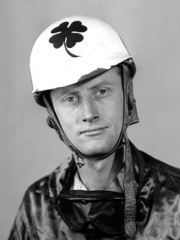
The Most Famous
RACING DRIVERS from United States
This page contains a list of the greatest American Racing Drivers. The pantheon dataset contains 1,080 Racing Drivers, 134 of which were born in United States. This makes United States the birth place of the 3rd most number of Racing Drivers behind United Kingdom, and Italy.
Top 10
The following people are considered by Pantheon to be the top 10 most legendary American Racing Drivers of all time. This list of famous American Racing Drivers is sorted by HPI (Historical Popularity Index), a metric that aggregates information on a biography's online popularity. Visit the rankings page to view the entire list of American Racing Drivers.

1. Carroll Shelby (1923 - 2012)
With an HPI of 69.66, Carroll Shelby is the most famous American Racing Driver. His biography has been translated into 30 different languages on wikipedia.
Carroll Hall Shelby (January 11, 1923 – May 10, 2012) was an American automotive designer, racing driver, and entrepreneur. Shelby was involved with the AC Cobra and Mustang for the Ford Motor Company. With driver Ken Miles, he developed the Ford GT40, the car that won the 24 Hours of Le Mans in 1966, 1967, 1968, and 1969. As of 2024, it remains the only American-built car to win at Le Mans. Their efforts were dramatized in the 2019 Oscar-winning film Ford v Ferrari (titled Le Mans '66 in some European countries). Shelby and co-driver Roy Salvadori won the 1959 24 Hours of Le Mans driving an Aston Martin DBR1. He won the 1960 Sports Car Club of America United States Auto Club Road Racing Sports Car Championship by winning the round-one race at Riverside International Raceway in a Maserati Tipo 61 "Birdcage" and winning round two at Continental Divide Raceways in a Chevrolet Scarab Mark II. In 1962, Shelby established Shelby American to manufacture and market performance vehicles. His autobiography, The Carroll Shelby Story, was published in 1967.

2. Phil Hill (1927 - 2008)
With an HPI of 67.75, Phil Hill is the 2nd most famous American Racing Driver. His biography has been translated into 43 different languages.
Philip Toll Hill Jr. (April 20, 1927 – August 28, 2008) was an American racing driver, who competed in Formula One from 1958 to 1966. Hill won the Formula One World Drivers' Championship in 1961 with Ferrari, and won three Grands Prix across eight seasons. In endurance racing, Hill was a three-time winner of both the 24 Hours of Le Mans and the 12 Hours of Sebring, all with Ferrari. Upon winning the 24 Hours of Daytona in 1964 with NART, Hill became the first driver to complete the Triple Crown of endurance racing. Hill was one of two American drivers to win the World Drivers' Championship alongside Mario Andretti, and the only one who was born in the United States. Hill was described as a "thoughtful, gentle man" and once said, "I'm in the wrong business. I don't want to beat anybody, I don't want to be the big hero. I'm a peace-loving man, basically."

3. Danny Sullivan (b. 1950)
With an HPI of 62.60, Danny Sullivan is the 3rd most famous American Racing Driver. His biography has been translated into 22 different languages.
Daniel John Sullivan III (born March 9, 1950), better known as Danny Sullivan, is an American former racing driver. He earned 17 wins in the CART Indy Car World Series, including the 1985 Indianapolis 500. Sullivan won the 1988 CART Championship, and placed third in points in 1986. Sullivan also scored a victory in IROC. He competed in the 1983 Formula One season with Tyrrell, scoring 2 championship points.

4. Ken Block (1967 - 2023)
With an HPI of 61.44, Ken Block is the 4th most famous American Racing Driver. His biography has been translated into 31 different languages.
Kenneth Paul Block (November 21, 1967 – January 2, 2023) was an American professional rally driver with the Hoonigan Racing Division, formerly known as the Monster World Rally Team. Block was also one of the co-founders of DC Shoes. He also competed in many action sports events, including skateboarding, snowboarding, and motocross. After selling his ownership of DC Shoes, Block shifted his business focus to Hoonigan Industries, an apparel brand for auto enthusiasts. He was the co-owner and "Head Hoonigan In Charge" (HHIC) at the company before his death in a snowmobile accident in January 2023. His daughters Lia Block and Kira Block and his son Mika Block are also racing drivers.
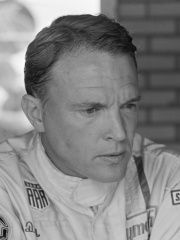
5. Dan Gurney (1931 - 2018)
With an HPI of 61.13, Dan Gurney is the 5th most famous American Racing Driver. His biography has been translated into 29 different languages.
Daniel Sexton Gurney (April 13, 1931 – January 14, 2018) was an American racing driver, engineer and motorsport executive, who competed in Formula One from 1959 to 1970. Widely regarded as one of the most influential figures in the history of motorsport, Gurney won four Formula One Grands Prix across 11 seasons. In endurance racing, Gurney won the 24 Hours of Le Mans in 1967 with Ford, as well as the 12 Hours of Sebring in 1959 with Ferrari. Born in Long Island, Gurney was the son of bass-baritone John R. Gurney and born into a family of engineers. Interested by California hot rod culture, Gurney built his first car aged 19 and became an amateur drag racer. After serving in the United States Army as an artillery mechanic during the Korean War, Gurney entered the 1957 Riverside Grand Prix, beating numerous established drivers including Phil Hill and attracting the attention of Luigi Chinetti, who organised his professional debut at the 24 Hours of Le Mans in 1958 with NART. His performance at Le Mans prompted Ferrari to sign Gurney for the 1959 season, making his Formula One debut at the French Grand Prix after winning the 12 Hours of Sebring with the team two months prior. After achieving two podiums in only four races at Ferrari, Gurney joined BRM in 1960. Following a non-classified championship finish with BRM, Gurney moved to Porsche, where he scored frequent podiums and finished fourth in the 1961 World Drivers' Championship. He took his maiden win at the 1962 French Grand Prix, which remains Porsche's only victory as a constructor in Formula One. Gurney moved to Brabham in 1963 as their first-ever driver, taking multiple wins in three seasons at the team, including another fourth-placed championship finish in 1965. Alongside Carroll Shelby, Gurney had founded All American Racing in 1964, entering Formula One with Gurney at the wheel in 1966 under the chassis name Eagle. Despite struggling for reliability with the Len Terry-designed Eagle T1, Gurney took his final victory at the 1967 Belgian Grand Prix, before leaving the sport at the end of 1968. He returned at three Grands Prix in 1970 for McLaren, following the death of Bruce McLaren. Gurney achieved four wins, three pole positions, six fastest laps and 19 podiums in Formula One, amongst winning the non-championship 1967 Race of Champions. Outside of Formula One, Gurney entered ten editions of the 24 Hours of Le Mans from 1958 to 1967, winning the latter alongside A.J. Foyt in the Ford GT40 Mk IV. His celebration upon winning Le Mans—spraying champagne on the podium—has since become a custom throughout global motorsport. Gurney was a record five-time winner of the Winston Western 500 in the NASCAR Grand National Series and, in American open-wheel racing, was a six-time race winner in USAC Championship Car and twice runner-up in the Indianapolis 500 in 1968 and 1969. He was also a race-winner in the Canadian-American Challenge Cup, the Trans-Am Series and the British Saloon Car Championship. In aerodynamics, he is remembered for his invention of the Gurney flap, and became the first Formula One driver to wear a full-face helmet at the 1968 German Grand Prix. His All American Racers team won 78 official races, including the Indianapolis 500 and the 24 Hours of Daytona. Gurney was inducted into the International Motorsports Hall of Fame in 1990.

6. Richie Ginther (1930 - 1989)
With an HPI of 60.87, Richie Ginther is the 6th most famous American Racing Driver. His biography has been translated into 25 different languages.
Paul Richard "Richie" Ginther (5 August 1930 – 20 September 1989) was an American racing driver, who competed in Formula One from 1960 to 1967. He recorded the first Formula One win for both Honda and Goodyear at the Mexican Grand Prix in 1965. Born in Hollywood, Ginther competed in Formula One for Ferrari, Scarab, BRM, Honda, Cooper and Eagle. He finished third in the 1963 World Drivers' Championship with BRM, and scored 14 podiums across eight seasons. Ginther was inducted into the Motorsports Hall of Fame of America in 2008.

7. Jerry Unser Jr. (1932 - 1959)
With an HPI of 60.55, Jerry Unser Jr. is the 7th most famous American Racing Driver. His biography has been translated into 18 different languages.
Jeremy Michael Unser Jr. (November 15, 1932 – May 17, 1959) was an American racecar driver. He was the 1957 USAC Stock Car champion. Jerry was the first of the Unser family to compete at Indianapolis. In his only start, in 1958, he was caught up in a 13-car pileup on the first lap and flew over the turn three wall, emerging unhurt. He died in a practice crash before the 1959 Indianapolis 500, leaving behind a widow, Jeanne Unser, and two sons, Jerry and Johnny Unser. Unser's brothers Al and Bobby and his nephew Al Jr. have won the "500". His son Johnny and nephew Robby have also competed in the race.

8. Brett Lunger (b. 1945)
With an HPI of 60.43, Brett Lunger is the 8th most famous American Racing Driver. His biography has been translated into 19 different languages.
Robert Brett Lunger (born November 14, 1945) is an American racecar driver. Lunger was educated at the Holderness School, and Princeton University. He dropped out of Princeton after three years to enlist for service in Vietnam. He was a political science major. At the time he was preparing a thesis on U.S. policy on Southeast Asia. The Gulf of Tonkin Incident refuted much of what Lunger contended in his writing. A former US Marine lieutenant who served in the Vietnam war, his racing career was mostly spent in privateer cars, paid for by his family wealth, as Lunger's mother, Jane du Pont Lunger, was an heiress to the Du Pont family fortune and a prominent racehorse breeder. Lunger participated in 43 Formula One World Championship Grands Prix, debuting in 1975, without scoring any championship points during his four seasons in Formula One. Lunger's Formula One career started alongside James Hunt in the Hesketh team, followed by a season with Surtees in 1976. For 1977, he started the season with a year-old March 761 run by Bob Sparshott and entered under the name of his sponsor, Chesterfield Racing, but switched to a McLaren M23 after three races. In 1978, he stayed with the McLaren M23 and also tried an M26, but now entered by Sparshott's racing outfit, BS Fabrications. After a one-off drive for Ensign at the end of the season, Lunger moved on to sports car racing. Lunger is also known for helping to rescue Niki Lauda from his burning Ferrari in 1976 at the Nürburgring.

9. Pat Flaherty (1926 - 2002)
With an HPI of 59.87, Pat Flaherty is the 9th most famous American Racing Driver. Her biography has been translated into 19 different languages.
George Francis "Pat" Flaherty (January 6, 1926 – April 9, 2002) was an American racing driver who won the Indianapolis 500 in 1956.
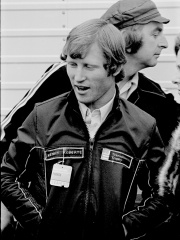
10. Kenny Roberts (b. 1951)
With an HPI of 59.58, Kenny Roberts is the 10th most famous American Racing Driver. His biography has been translated into 18 different languages.
Kenneth Leroy Roberts (born December 31, 1951) is an American former professional motorcycle racer and racing team owner. In 1978, he became the first American to win a Grand Prix motorcycle racing world championship. He was also a two-time winner of the A.M.A. Grand National Championship. Roberts is one of only four riders in American Motorcyclist Association (AMA) racing history to win the AMA Grand Slam, representing Grand National wins at a mile, half-mile, short-track, TT Steeplechase and road race events. Roberts left his mark on Grand Prix motorcycle racing as a world championship winning rider, a safety advocate, a racing team owner, and as a motorcycle engine and chassis constructor. His dirt track-based riding style changed the way Grand Prix motorcycles were ridden. Roberts' proposal to create a rival motorcycle championship in 1979 broke the Fédération Internationale de Motocyclisme (FIM) hegemony and increased the political clout of Grand Prix racers, which subsequently led to improved safety standards and a new era of professionalism in the sport. In 2000, Roberts was named a Grand Prix Legend by the FIM. He is also the father of 2000 Grand Prix world champion Kenny Roberts Jr.
People
Pantheon has 134 people classified as American racing drivers born between 1902 and 2000. Of these 134, 60 (44.78%) of them are still alive today. The most famous living American racing drivers include Danny Sullivan, Brett Lunger, and Kenny Roberts. The most famous deceased American racing drivers include Carroll Shelby, Phil Hill, and Ken Block. As of April 2024, 12 new American racing drivers have been added to Pantheon including Zak Brown, Jimmy Vasser, and John Andretti.
Living American Racing Drivers
Go to all RankingsDanny Sullivan
1950 - Present
HPI: 62.60
Brett Lunger
1945 - Present
HPI: 60.43
Kenny Roberts
1951 - Present
HPI: 59.58
Wayne Rainey
1960 - Present
HPI: 59.41
Rikky von Opel
1947 - Present
HPI: 58.24
Kevin Schwantz
1964 - Present
HPI: 57.44
Roger Penske
1937 - Present
HPI: 57.37
Dale Earnhardt Jr.
1974 - Present
HPI: 57.36
Richard Petty
1937 - Present
HPI: 57.15
Eddie Cheever
1958 - Present
HPI: 56.15
Freddie Spencer
1961 - Present
HPI: 56.07
Michael Andretti
1962 - Present
HPI: 54.25
Deceased American Racing Drivers
Go to all RankingsCarroll Shelby
1923 - 2012
HPI: 69.66
Phil Hill
1927 - 2008
HPI: 67.75
Ken Block
1967 - 2023
HPI: 61.44
Dan Gurney
1931 - 2018
HPI: 61.13
Richie Ginther
1930 - 1989
HPI: 60.87
Jerry Unser Jr.
1932 - 1959
HPI: 60.55
Pat Flaherty
1926 - 2002
HPI: 59.87
Jack McGrath
1919 - 1955
HPI: 58.88
Jim Rathmann
1928 - 2011
HPI: 58.31
Lee Wallard
1910 - 1963
HPI: 58.28
Peter Revson
1939 - 1974
HPI: 58.15
George Constantine
1918 - 1968
HPI: 57.58
Newly Added American Racing Drivers (2025)
Go to all RankingsZak Brown
1971 - Present
HPI: 49.76
Jimmy Vasser
1965 - Present
HPI: 40.99
John Andretti
1963 - 2020
HPI: 39.64
Ricky Carmichael
1979 - Present
HPI: 37.79
Michael Waltrip
1963 - Present
HPI: 36.20
Colton Herta
2000 - Present
HPI: 35.70
Sarah Fisher
1980 - Present
HPI: 35.01
Paul Dana
1975 - 2006
HPI: 34.39
Sam Hornish Jr.
1979 - Present
HPI: 31.41
Martin Truex Jr.
1980 - Present
HPI: 30.75
Clint Bowyer
1979 - Present
HPI: 27.92
Toni Breidinger
1999 - Present
HPI: 22.21
Overlapping Lives
Which Racing Drivers were alive at the same time? This visualization shows the lifespans of the 25 most globally memorable Racing Drivers since 1700.

